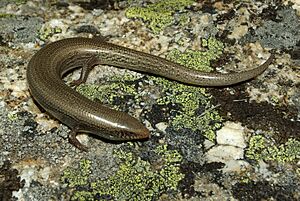Bedriaga's skink facts for kids
Quick facts for kids Bedriaga's skink |
|
|---|---|
 |
|
| Conservation status | |
| Scientific classification | |
| Genus: |
Chalcides
|
| Species: |
bedriagai
|
| Synonyms | |
|
|
The Bedriaga's skink (Chalcides bedriagai) is a type of lizard. It belongs to the Scincidae family, which includes many kinds of skinks. This special lizard only lives in the Iberian Peninsula, which is where Spain and Portugal are located.
Bedriaga's skinks usually like to live in sandy places. They prefer areas with some plants but also good places to hide. You might also find them in open forests. They are good at digging into loose soil to make homes. Female skinks give birth to live babies, not eggs. These skinks are active during the day and around sunset. They are quite shy. An adult skink can grow to about 16 cm (6 inches) long, including its tail. Each of its feet has five toes. They eat small creatures like insects, spiders, slugs, and woodlice.
Contents
What's in a Name? The Bedriaga's Skink
The name bedriagai for this skink comes from a person. It honors a Russian scientist named Jacques von Bedriaga. He studied reptiles and amphibians.
Meet the Bedriaga's Skink: Appearance
The Bedriaga's skink looks a bit like a smaller version of the ocellated skink. It has a small head and a long, round body. Its legs are short, and each foot has five toes. This skink can grow up to 17 cm (about 6.7 inches) long. At least half of its length is its tail, which is fairly wide.
Female skinks are usually bigger than males. Sometimes, a skink's tail might break off. But don't worry, it can grow back! Around the middle of its body, it has 24 to 28 rows of scales. The skink's color can be light brown, yellowish-brown, or gray. It often has many small, black-edged spots that look like eyes. There is usually a lighter line running along each side of its body. Young skinks are often darker in color.
Where Do Bedriaga's Skinks Live?
Bedriaga's skinks are found in Spain and Portugal. They are mostly missing from northern Spain. In other areas, they are found in scattered groups. You can also find them on some islands. These include the Islas del Mar Menor and Isla de Nueva Tabarca in the Mediterranean Sea. They also live on Atlantic islands like the Cies Islands, Pessegueiro Island, Ons Island, and Islote de Sancti Petri.
Their favorite home is sandy heathland with small bushes. They also like sandy areas with more plants. You might see them in open woodlands, clearings, and rocky hillsides. They can live at heights up to about 1,750 meters (5,740 feet) above sea level. These skinks can even live in areas that have been changed a bit by humans.
Different Types of Bedriaga's Skinks
There are a few different kinds, or subspecies, of Bedriaga's skink:
- Chalcides bedriagai bedriagai (Boscá, 1880)
- Chalcides bedriagai cobosi Valverde, 1966
- Chalcides bedriagai pistaciae Valverde, 1966
How Bedriaga's Skinks Behave
Bedriaga's skinks are active during the day. They eat many kinds of small creatures without backbones, like insects. They are quite secretive and like to warm up in the sun in hidden spots. If they feel threatened, they quickly hide in thick plants or underground. They can dig into loose soil very fast.
When it's time to breed, male skinks can become territorial. This means they will protect their space and sometimes fight other males. Female skinks can mate with more than one male. They give birth to live young. After about eleven weeks, one to six baby skinks are born. When they first come out, the baby skinks are about 6 cm (2.4 inches) long.
The Future of Bedriaga's Skinks
The Bedriaga's skink faces some challenges. Their homes are changing because of more tree planting or building near the coast. Also, an increase in the number of wild boar (Sus scrofa) might affect them. Scientists believe the number of these skinks is going down. This is especially true for some groups living on islands. Because of this, the IUCN (International Union for Conservation of Nature) has listed the Bedriaga's skink as "Near Threatened". This means they could become endangered in the future if things don't improve.


